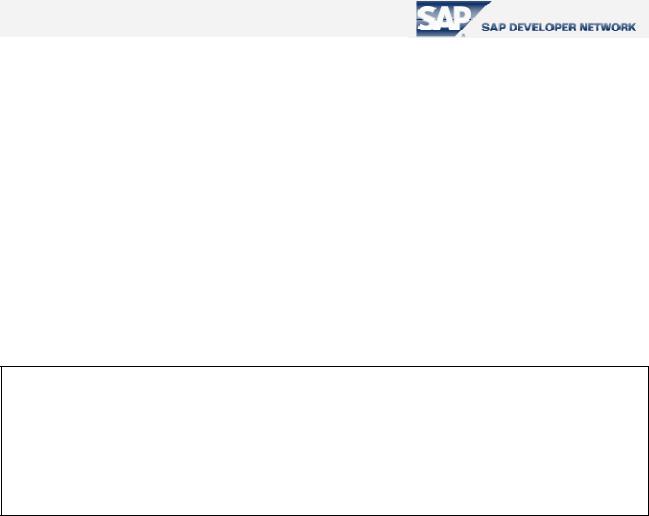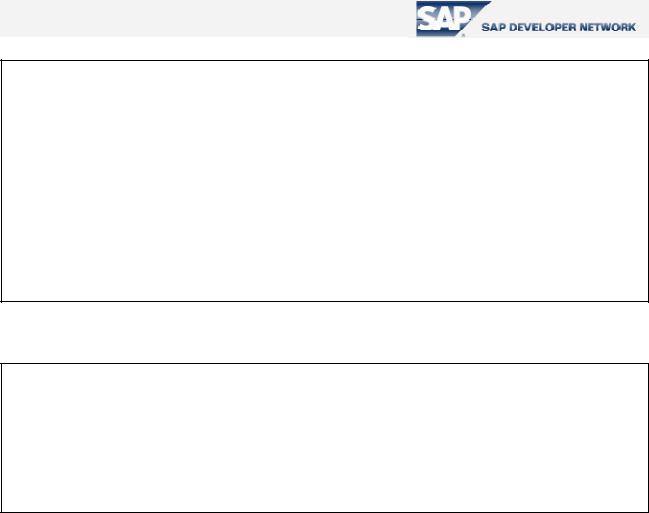
- •Disclaimer & Liability Notice
- •Applies To:
- •Summary
- •Prerequisites
- •Table of Contents
- •Introduction
- •Building Blocks
- •General Scheme
- •Building Field Catalog
- •Structure Of A Field Catalog
- •Building Field Catalog Semi-Automatically
- •Layout Adjustments
- •Printing Adjustments
- •Excluding Unwanted Standard Function Buttons
- •Non-Event Based Additional Functionalities
- •Changing Field Catalog or Layout after First Display
- •Setting Sort Conditions
- •Filtering
- •Making Selections
- •Retrieving and Setting Scroll Status Info
- •Coloring
- •Coloring an Entire Column
- •Coloring An Entire Row
- •Coloring Individual Cells
- •Inserting Hyperlinks
- •Making Fields As Dropdown Lists
- •Managing Display Variants
- •Event Based Additional Functionalities
- •General Scheme for the Event Handler Class
- •Hotspot Clicking
- •Double Clicking
- •Pushbuttons On The List
- •Adding Your Own Functions
- •Overriding Standard Functions
- •Context Menus
- •About Printing
- •Making ALV Grid Editable
- •Controlling Data Changes
- •Linking F1 Help to Fields
- •Linking F4 Help to Fields
- •A Piece of Troubleshooting
- •Author Bio

An Easy Reference for ALV Grid Control
Controlling Data Changes
As we can now make our ALV Grid editable we may require controlling input data. The ALV Grid has events “data_changed” and “data_changed_finished”. The former method is triggered just after the change at an editable field is perceived. Here you can make checks for the input. And the second event is triggered after the change is committed.
You can select the way how the control perceives data changes by using the method “register_edit_event”. You have two choices:
i.After return key is pressed: To select this way, to the parameter “i_event_id” pass
“cl_gui_alv_grid=>mc_evt_enter”.
ii. After the field is modified and the cursor is moved to another field: For this, pass “cl_gui_alv_grid=>mc_evt_modifies” to the same parameter.
To make events controlling data changes be triggered, you must select either way by calling this method. Otherwise, these events will not be triggered.
To control field data changes, ALV Grid uses an instance of the class “CL_ALV_CHANGED_DATA_PROTOCOL” and passes this via the event “data_changed”. Using methods of this class, you can get and modify cell values and produce error messages. Here are some of those methods:
get_cell_value |
Gets the cell value. You pass the address of the cell to |
the interface. |
|
modify_cell |
Modifies the cell value addressed via parameters. |
add_protocol_entry |
Add a log entry. You make use of standard message |
interface with message type, message id, etc… |
|
protocol_is_visible |
Make the error table visible or not. |
refresh_protocol |
Refreshing log entries. |
Table 16 – Methods to use for controlling data changes
With the reference of the instance, you can reach information about modifications. These useful attribute tables are:
MT_MOD_CELLS |
Contains addresses of modified cells with “row_id”s |
|
and “fieldname”s. |
||
|
||
MP_MOD_ROWS |
Contains modified rows. Its type is generic. |
|
MT_GOOD_CELLS |
Contains cells having proper values |
|
MT_DELETED_ROWS |
Contains rows deleted from the list |
|
MT_INSERTED_ROWS |
Contains rows inserted to the list |
Table 17 – Attribute tables to be used for controlling data changes
Utilizing these methods and attributes you can check and give proper message and also modify the cell content.
© 2005 SAP AG |
49 |

An Easy Reference for ALV Grid Control
FORM handle_data_changed USING ir_data_changed
|
TYPE REF TO cl_alv_changed_data_protocol. |
DATA : ls_mod_cell |
TYPE lvc_s_modi , |
lv_value |
TYPE lvc_value . |
SORT ir_data_changed->mt_mod_cells BY row_id .
LOOP AT ir_data_changed->mt_mod_cells
INTO ls_mod_cell
WHERE fieldname = 'SEATSMAX' .
CALL METHOD ir_data_changed->get_cell_value
EXPORTING i_row_id |
= ls_mod_cell-row_id |
|
i_fieldname |
= |
'CARRID' |
IMPORTING e_value |
= |
lv_value . |
IF lv_value = 'THY' AND ls_mod_cell-value > '500' .
CALL METHOD ir_data_changed->add_protocol_entry
EXPORTING i_msgid = 'SU' i_msgno = '000' i_msgty = 'E'
i_msgv1 = 'This number can not exceed 500 for ' i_msgv2 = lv_value
i_msgv3 = 'The value is et to ''500''' i_fieldname = ls_mod_cell-fieldname i_row_id = ls_mod_cell-row_id .
CALL METHOD ir_data_changed->modify_cell
EXPORTING i_row_id |
= ls_mod_cell-row_id |
i_fieldname |
= ls_mod_cell-fieldname |
i_value |
= '500' . |
ENDIF . |
|
ENDLOOP . |
|
ENDFORM |
" handle data changed |
Code Part 34 – Checking the input together with anon-input value, adding a log and modifying the cell content
© 2005 SAP AG |
50 |

An Easy Reference for ALV Grid Control
The event “data_changed” makes you aware about F4 functions. It sets the appropriate parameter from the group with respect to where it was triggered. These parameters are { E_ONF4, E_ONF4_BEFORE, E_ONF4_AFTER }.
Linking F1 Help to Fields
To link your own F1 help to a field, you should simply utilize the event “onf1”. At this point, it is assumed that you know how to define, implement and register an event. The event has following parameters at its interface:
¾E_FIELDNAME of type LVC_FNAME
¾ES_ROW_NO of type LVC_S_ROID
¾ER_EVENT_DATA reference to type CL_ALV_EVENT_DATA
And, here is a simple sample code for the method.
METHOD handle_on_f1 .
PERFORM f1_help USING e_fieldname es_row_no . er_event_data->m_event_handled = 'X' .
ENDMETHOD .
Code Part 35 - A sample code for the event”onf1”
Here we set the attribute “er_event_data->m_event_handled” to prevent further processing of standard F1 help.
Linking F4 Help to Fields
For the last section, we will deal with linking F4 help to fields. It is easy. As usual, define, implement and register the event “onf4” at proper places in your code. For F4 help, you must register the fields whose F4 request will trigger the “onf4” event. For this you must prepare a table of type “LVC_T_F4” and register this table using the method “register_f4_for_fields”. While preparing table you must include a line for each field which will trigger F4 event. For each field in the structure;
¾Pass the fieldname to ‘FIELDNAME’
¾Set ‘REGISTER’ to make the field registered,
¾Set ‘GETBEFORE’ to provide field content transport before F4 in editable mode
¾Set ‘CHNGEAFTER’ to make the data changed after F4 in editable mode.
© 2005 SAP AG |
51 |

An Easy Reference for ALV Grid Control
DATA: lt_f4 TYPE lvc_t_f4 WITH HEADER LINE .
.. ..
lt_f4-fieldname = 'PRICE'. lt_f4-register = 'X' . lt_f4-getbefore = 'X' . APPEND lt_f4 .
CALL METHOD gr_alvgrid->register_f4_for_fields
EXPORTING
it_f4 = lt_f4[] .
Code Part 36 – Preparing table for the fields to be registered to trigger F4 event
METHOD handle_on_f4 .
PERFORM f4_help USING e_fieldname es_row_no . er_event_data->m_event_handled = 'X' .
ENDMETHOD .
Code Part 37 – A sample “onf4” method implementation
Again, we set the attribute “er_event_data->m_event_handled” to prevent further processing of standard F4 help.
© 2005 SAP AG |
52 |
